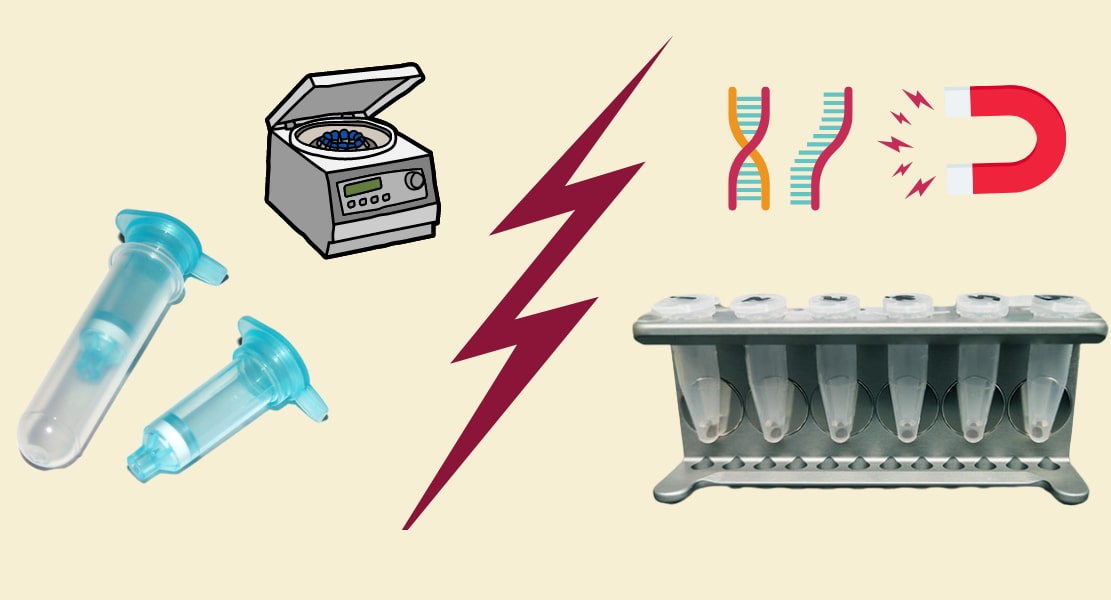Pureté, efficacité et polyvalence
Nucleic acid isolation is an essential step in molecular biology and genetic research. It involves extracting and purifying DNA or RNA from a sample of interest. Traditional nucleic acid isolation methods rely on spin-column technology, which uses silica-based columns to bind and purify nucleic acids. However, magnetic bead-based nucleic acid isolation methods have gained popularity in recent years due to their advantages over spin column methods. This article will discuss the benefits of switching from spin columns to magnetic bead-based nucleic acid isolation methods.
Speed and Efficiency
Magnetic bead-based nucleic acid isolation methods are faster and more efficient than traditional spin column methods. Magnetic beads have a larger surface area than silica-based columns, which allows for faster binding and elution of nucleic acids. Additionally, using magnetic beads allows for automation and high-throughput processing, making it ideal for laboratories that process large numbers of samples.
Increased Yield and Purity
Magnetic bead-based nucleic acid isolation methods provide higher yield and purity of nucleic acids compared to spin column methods. Magnetic beads have a high binding capacity, which ensures that all nucleic acids are captured and purified. Furthermore, magnetic bead-based methods use fewer chemicals and reagents, which reduces the risk of contamination and leads to higher purity of nucleic acids.
Versatility
Magnetic bead-based nucleic acid isolation methods are versatile and can be used for various applications, including DNA and RNA isolation, sequencing, and PCR. Using magnetic beads also allows for the isolation of nucleic acids from different sources, such as blood, tissue, and saliva. This makes it an ideal method for researchers working on various projects.
Reproducibility and Consistency
Magnetic bead-based nucleic acid isolation methods offer reproducibility and consistency in results. The use of automated magnetic bead-based systems ensures that each sample is processed in the same way, reducing the risk of experimental errors. Additionally, using standardized protocols and magnetic bead-based kits ensures that the results are consistent and reproducible.
Cost-Effective
Magnetic bead-based nucleic acid isolation methods are cost-effective in the long run. While the initial investment in magnetic bead-based systems may be higher than spin column methods, the use of magnetic beads allows for higher throughput and reduced processing time. This can lead to significant cost savings over time, especially for laboratories that process a large number of samples.
Environmentally Friendly
Magnetic bead-based nucleic acid isolation methods are more environmentally friendly than spin column methods. Magnetic beads are reusable and can be easily cleaned and sterilized, reducing the amount of waste generated. Additionally, the use of magnetic bead-based systems reduces the use of hazardous chemicals and reagents, making it a safer and more sustainable option.
In conclusion, the advantages of switching from spin column to magnetic bead-based nucleic acid isolation methods are straightforward. Magnetic bead-based methods offer faster processing time, higher yield and purity, versatility, reproducibility and consistency, cost-effectiveness, and environmental sustainability. While spin column methods have been the traditional method for nucleic acid isolation, the benefits of magnetic bead-based methods make it an attractive alternative for researchers and laboratories looking to improve their nucleic acid isolation processes.

